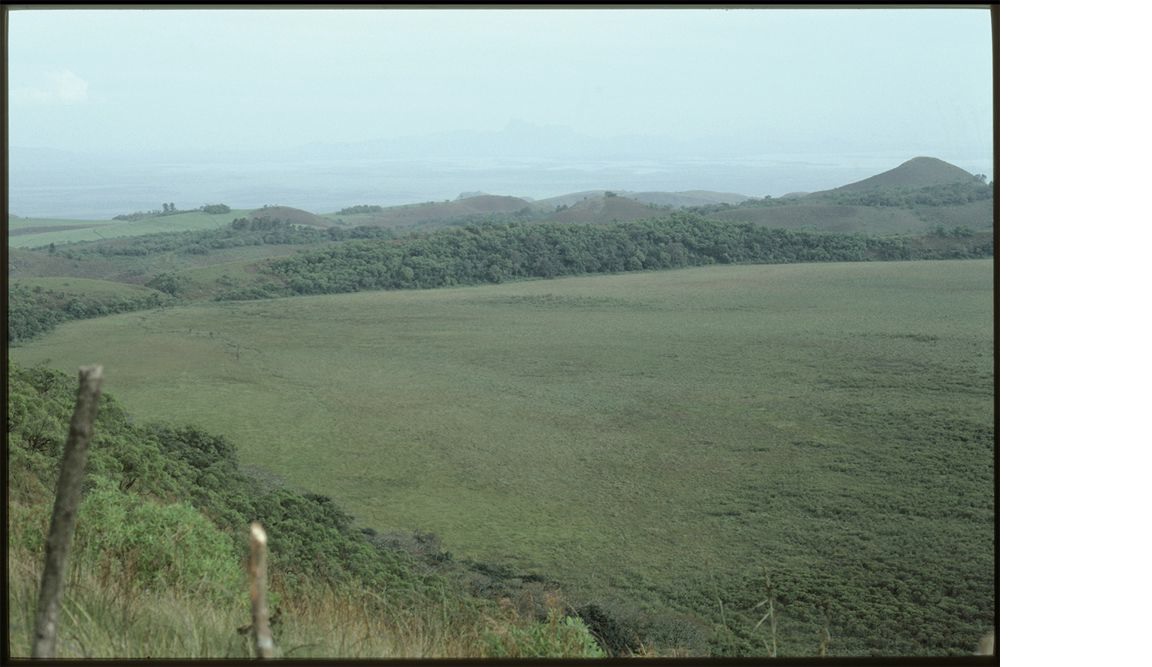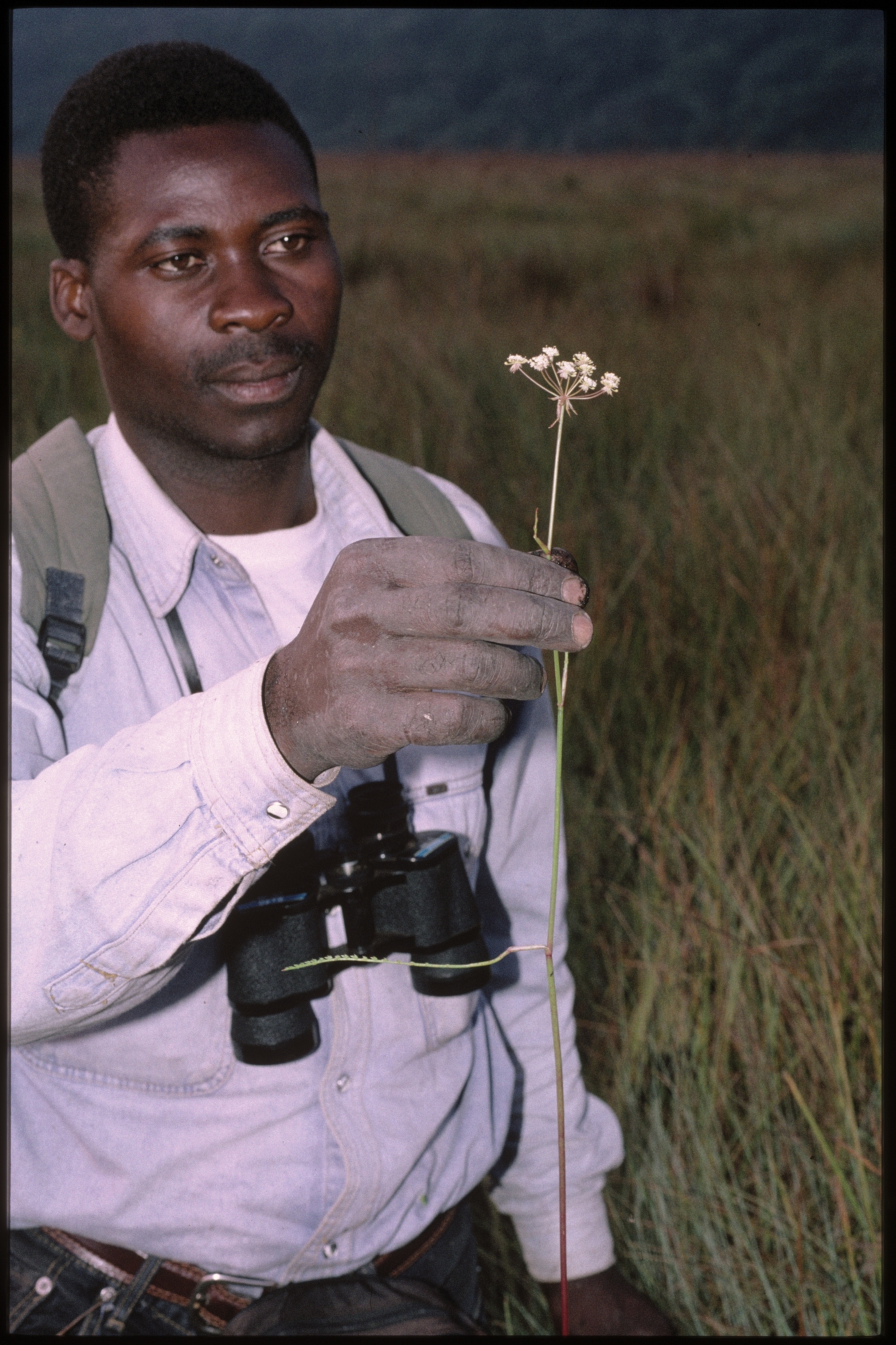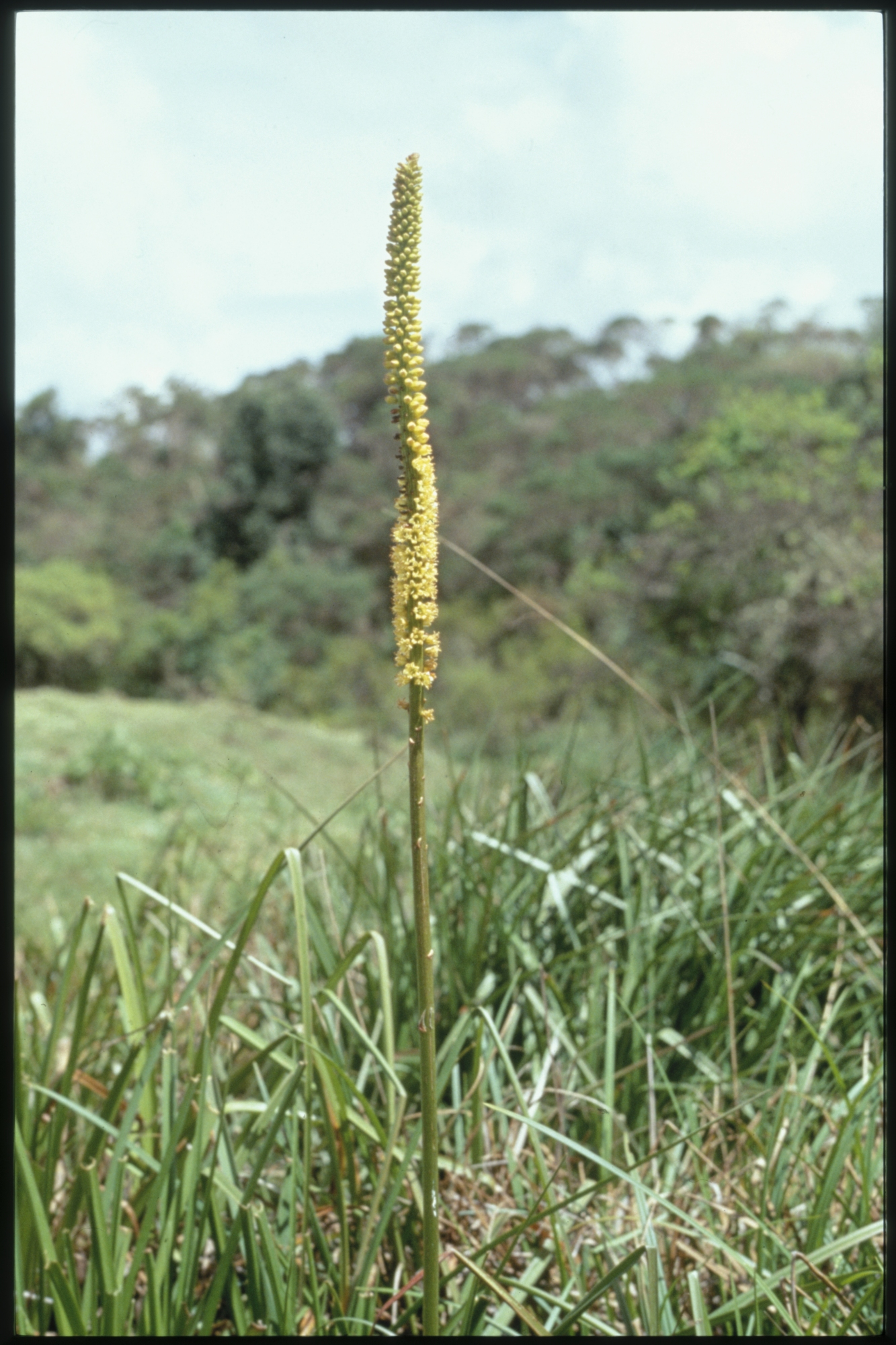
Country: Cameroon
Administrative region: Northwest (Region)
Central co-ordinates: 6.08970 N, 10.34880 E
Area: 32.5km²
Qualifying IPA Criteria
A(i)Site contains one or more globally threatened species
IPA assessment rationale
Mbi crater lake qualifies as a potential IPA under criterion A(i) due the abundant presence of the globally endangered Kniphofia reflexa and the occurrence of Eugenia gilgi (CR), Justicia teloensis (VU) and Stachys psdeudohumifusa subsp. saxeri. Afrocarum imbricatum is also found at the site and nowhere else in Cameroon.
Site description
Mbi Crater lake is located northeast of the city of Bamenda in Belo subdivision of Boyo division, Northwest Region, Cameroon. The crater lake is a faunal reserve surrounded by land owned by the private Elba ranch and Ndawara plantation. Beyond this, to the west, the Mbingo baptist church and hospital owns the Mbingo forest, an area of approximately 4 km. It is unclear where the boundary of the Mbingo forest and the Elba ranch is located but there is an extensive area of partially forested land between the hospital and the lake (BirdLife International, 2000). To the north, a ridge of continuous high land also connects the site with Lake Oku and the Kilim Ijim reserve, although this bridge of land appears to be grassland and pasture, with buildings spreading up the slopes.



Botanical significance
The Mbi crater itself harbours nine globally threatened taxa, including the Critically Endangered tree Eugenia gilgii recorded from the narrow wooded slopes forming the perimeter of the lake, and the Endangered "Red Hot Poker" species, Kniphofia reflexa which occurs in great abundance at this small site (Cheek et al., 2000). These species were recorded during a brief visit by botanists from the Cameroon National Herbarium, MINEF and RBG Kew; this is believed to be the only recorded botanical surveying effort at the lake. Kniphofia reflexa is endemic to Cameroon and represents a northwesterly outlier from the rest of the genus. It is only known from two or three other nearby sites where it is less abundant (Cheek et al., 2000).
Afrocarum imbricatum (Berula imbricata) is recorded as the only known occurrence of the species in Cameroon (Cheek et al., 2000). Polystachya bamendae (EN) is recorded from high forest between the lake and Mbingo and is only known from one other collection 100 km away (Simo-Droissart et al., 2020). An unidentified Gladiolus sp. might also represent an additional undescribed globally threatened and locally endemic species (Cheek et al., 2000). More threatened species may well be present since only limited collecting has taken place at the site at a time when few species were flowering or fruiting (Cheek et al., 2000).
The Cameroon botanist Martin Etuge who collected specimens from the lake (including Justicia telloensis and Kniphofia reflexa) and who helped discover and describe many new taxa from this area and elsewhere in the country, sadly died at Mbingo hospital in 2020 after a struggle with cancer.
Habitat and geology
The Bamenda highlands, where the site is located, have a two-season monsoon climate with a distinct wet season between March and October when heavy rains come from the west. Average precipitation in nearby Bamenda, 1,000 m lower in altitude, is 2,145 mm per annum, with a peak in September of 383 mm (Climate-Data.org, 2020). Mean annual temperature at Bamenda is 21.5 °C, with monthly means varying only slightly between the peak at the beginning of the rainy season of 23 °C and a low of 20.5 °C at the height of the rains in August and September. However, at the altitude of the site itself temperatures do not exceed 18 °C and frost is possible although very rare (Suchel, 1988, cited by Lezine et al., 2019). Mist is also common at this altitude (Lezine et al., 2019).
The crater lake is at approximately 2,015 m altitude, with the rim rising steeply to the level of the plateau at c. 2,200m to the west but only c.15 m above the crater surface on the east side where the land subsequently drops away towards Lake Bamendjing and the Central Plateau.
In this area Tertiary volcanic basalts and trachytes overlay the pre-Cambrian Basement complex strata, with the land surface at this altitude part of the High Lava Plateau (Cheek et al., 2000). Soils of the High Lava Plateau are uniformly ferralitic clay soils, derived from Tertiary era rocks but with high organic content owing to the slow pace of decomposition at this altitude. However, the crater itself likely differs from surrounding soils. At nearby Bambuili lake (at similar altitude), the lake sediment is entirely organic, with higher decomposed content in the upper meters (Lezine et al., 2019).
Water exits the crater on the east side through a swampy river, irrigating the neighbouring Ndawara ranch and tea estate. Agwafo et al. (2016) indicate several other streams flowing from around the lake in different directions but these must arise from the rim rather than within the crater itself.
The crater, which is completely flat and lacking trees or shrubs, appears to be partly permanent swamp and partly seasonally inundated grassland, vegetated by tussock forming sedges and grasses up to 0.8–1.5 m high, with Afrocarum imbricatum dominant and Rhytachne rottboelloides forming the largest tussocks (Agwafo et al., 2016; Cheek et al., 2000). Other tussock species include Fuirena stricta subsp. chlorocarpa, Xyris congensis and X. rehmannii, while Andropogon lacunosus, Scleria achtenii, Leersia hexandra, Sacciolepis chevalieri, Cyperus dichrostachys, Oldenlandia lancifolia, Polygonum cf. strigosum, Conyza clarenceana, Helichrysum forskahlii and Xyria capensis are also present. A thin strip of forest on the escarpment surrounds most of the lake, thickest on the western side; this habitat is characterised by the montane woodland genus Gnidia (BirdLife International, 2020).
Conservation issues
The lake is small (370 ha; Topa et al., 2009) and isolated, surrounded by a large ranch. Grazing from the ranch appears to have partly encroached on the crater which is managed as a faunal reserve (Cratère de Mbi) but is difficult for local authorities to access (Birdlife International, 2020). Trampling by livestock could also potentially threaten some species (Cheek et al 2000). The changed vegetation of the surrounding landscape could potentially affect the crater habitat by influencing the microclimate, and through pollution, sedimentation and nutrient leaching from the cultivated area (Agwafo et al., 2016).
The extent and regularity of inundation of this damp or partially flooded habitat is likely critical to the survival of some of the species. The only outlet from the crater flows through the ranch which might seek to manage this flow for irrigation. Climate change could also lead to drying of the swamp habitat.
Discussions between various state and non state actors regarding upgrading of the conservation status of the site have been halted by the conflict in the region since 2016 (K. Tah, 2021, pers. comm. 18 October).
The nearby Mbingo forest is included as an additional area of forest worth preserving together with the site. This forest is apparently owned by the Mbingo baptist church and hospital who support its conservation but have limited power to achieve this. Cheek et al. (2000) describe the Mbingo "Back Valley" forest as the only block of remaining forest below 1,800 m approaching 1 km2 in size in the Bamenda Highlands. The globally threatened Pentarrhinum ledermannii is recorded there (Cheek, 2014). The owners of the ranch which surrounds the lake and separates the forest from it are also reportedly sympathetic to conservation of the crater habitat (Cheek et al., 2000). Corridors connecting the lake, the forest and the Kilum-Ijim protected area (with native tree planting where necessary) should be considered through collaboration with these parties and with local organisations such as ANCO and ERUDEF which have successfully implemented reforestation schemes elsewhere.
Ecosystem services
The site is an Important Bird Area with 120 species recorded from limited visits (BirdLife International, 2020) including Tauraco bannermani (EN) and Platysteira laticincta (EN). Other fauna include the Blue Duiker (Cephalophus monticola) and Bushbuck (Tragelaphus scriptus) as well as several primates including Chimpanzee (Pan troglodytes) which is globally endangered and extremely threatened if not extinct at the site due to loss of the surrounding habitat: before the conflict that started in 2016, there were believed to be <5 individuals (K. Tah, 2021, pers. comm. 18 October). During inundated periods the lake potentially functions as a watering source for these fauna (Angwafo et al., 2020).
The swamp habitat also buffers seasonal rains and is the source of the outflowing stream which descends steeply to the Ndara tea plantation and community to the east and the much larger town of Babungo further below. It thus contributes to regular irrigation and protects against flooding and landslides which are a major threat in this area (Zogning et al., 2007).
The depth of the crater swamp peat is not known but could potentially provide a valuable site for pollen coring as well as a carbon store. At the nearby lake Bambili, (20 km southwest) cores from a similar altitude have been extracted dating back 90,000 years, providing valuable knowledge about vegetation change in the Cameroon highlands (Lezine et al., 2019).
Site assessor(s)
Bruce Murphy, Royal Botanic Gardens, Kew
Ben Pollard,
Martin Cheek, Royal Botanic Gardens Kew
Kenneth Tah, COMAID (formerly ANCO)
IPA criterion A species
| Species | Qualifying sub-criterion | ≥ 1% of global population | ≥ 5% of national population | 1 of 5 best sites nationally | Entire global population | Socio-economically important | Abundance at site |
|---|---|---|---|---|---|---|---|
| Eugenia gilgii Engl. & Brehme | A(i) |  |
 |
 |
 |
 |
|
| Kniphofia reflexa Hutch. ex Codd | A(i) |  |
 |
 |
 |
 |
Abundant |
| Justicia telloensis Hedrén | A(i) |  |
 |
 |
 |
 |
|
| Stachys pseudohumifusa subsp. saxeri | A(i) |  |
 |
 |
 |
 |
|
| Khaya ivorensis A.Chev. | A(i) |  |
 |
 |
 |
 |
|
| Prunus africana (Hook.f.) Kalkman | A(i) |  |
 |
 |
 |
 |
|
| Entandrophragma cylindricum (Sprague) Sprague | A(i) |  |
 |
 |
 |
 |
|
| Pentarrhinum ledermannii (Schlechter) Goyder & Liede | A(i) |  |
 |
 |
 |
 |
|
| Polystachya bamendae Szlach., Baranow & Mytnik | A(i), A(iii) |  |
 |
 |
 |
 |
|
| Diaphananthe bueae (Schltr.) Schltr. | A(i) |  |
 |
 |
 |
 |
Eugenia gilgii Engl. & Brehme





Kniphofia reflexa Hutch. ex Codd





Justicia telloensis Hedrén





Stachys pseudohumifusa subsp. saxeri





Khaya ivorensis A.Chev.





Prunus africana (Hook.f.) Kalkman





Entandrophragma cylindricum (Sprague) Sprague





Pentarrhinum ledermannii (Schlechter) Goyder & Liede





Polystachya bamendae Szlach., Baranow & Mytnik





Diaphananthe bueae (Schltr.) Schltr.





General site habitats
| General site habitat | Percent coverage | Importance |
|---|---|---|
| Wetlands (inland) - Bogs, Marshes, Swamps, Fens, Peatlands [generally over 8 ha] | 90 | |
| Forest - Subtropical/Tropical Moist Montane Forest | 10 |
Wetlands (inland) - Bogs, Marshes, Swamps, Fens, Peatlands [generally over 8 ha]
Forest - Subtropical/Tropical Moist Montane Forest
Land use types
| Land use type | Percent coverage | Importance |
|---|---|---|
| Nature conservation | 100 | Minor |
| Harvesting of wild resources | 100 | Minor |
Nature conservation
Harvesting of wild resources
Threats
| Threat | Severity | Timing |
|---|---|---|
| Agriculture & aquaculture - Annual & perennial non-timber crops - Agro-industry farming | Low | Future - inferred threat |
| Agriculture & aquaculture - Livestock farming & ranching - Agro-industry grazing, ranching or farming | Medium | Ongoing - trend unknown |
| Natural system modifications - Dams & water management/use - Abstraction of surface water (agricultural use) | Low | Future - inferred threat |
| Pollution - Agricultural & forestry effluents - Soil erosion, sedimentation | Unknown | Future - inferred threat |
| Pollution - Agricultural & forestry effluents - Nutrient loads | Unknown | Future - inferred threat |
| Climate change & severe weather - Droughts | Unknown | Future - inferred threat |
Agriculture & aquaculture - Annual & perennial non-timber crops - Agro-industry farming
Agriculture & aquaculture - Livestock farming & ranching - Agro-industry grazing, ranching or farming
Natural system modifications - Dams & water management/use - Abstraction of surface water (agricultural use)
Pollution - Agricultural & forestry effluents - Soil erosion, sedimentation
Pollution - Agricultural & forestry effluents - Nutrient loads
Climate change & severe weather - Droughts
Protected areas
| Protected area name | Protected area type | Relationship with IPA | Areal overlap |
|---|---|---|---|
| Mbi Crater faunal reserve | Local / Regional Nature Reserve | protected/conservation area matches IPA | 100 |
Mbi Crater faunal reserve
Conservation designation
| Designation name | Protected area | Relationship with IPA | Areal overlap |
|---|---|---|---|
| Mbi Crater Faunal Reserve - Mbingo forest | Important Bird Area | protected/conservation area matches IPA | 25 |
| Mbi Crater Faunal Reserve - Mbingo forest | Key Biodiversity Area | protected/conservation area matches IPA |  |
Mbi Crater Faunal Reserve - Mbingo forest
Mbi Crater Faunal Reserve - Mbingo forest

Management type
| Management type | Description | Year started | Year finished |
|---|---|---|---|
| No management plan in place | Unknown if there is one. |  |
 |
No management plan in place


Bibliography
The Plants of Mount Oku and the Ijim Ridge, Cameroon, A Conservation Checklist.
The catastrophic geomorphological processes in humid tropical Africa: A case study of the recent landslide disasters in Cameroon
Sedimentary Geology, Vol 199, page(s) 13 – 27 Available online
Important Bird Areas factsheet: Mbi Crater Faunal Reserve - Mbingo forest.
A 90,000-year record of Afromontane forest responses to climate change
Science, Vol 363, page(s) 177–181
Status of Medium-sized Mammals in Mbi Crater Game Reserve, North West Region, Cameroon Case Study of: Blue Duiker (Cephalophus monticola) and Bushbuck (Tragelaphus scriptus)
Annual Research & Review in Biology, Vol 11(2), page(s) 1-13
Bamenda Climate (Cameroon)
Pentarrhinum ledermannii. The IUCN Red List of Threatened Species 2014: e.T200706A2680928
Polystachya bamendae. The IUCN Red List of Threatened Species 2020: e.T87751190A87757914.
Recommended citation
Bruce Murphy, Ben Pollard, Martin Cheek, Kenneth Tah (2024) Tropical Important Plant Areas Explorer: Mbi Crater Lake (Cameroon). https://tipas.kew.org/site/mbi-crater-lake/ (Accessed on 27/07/2024)


